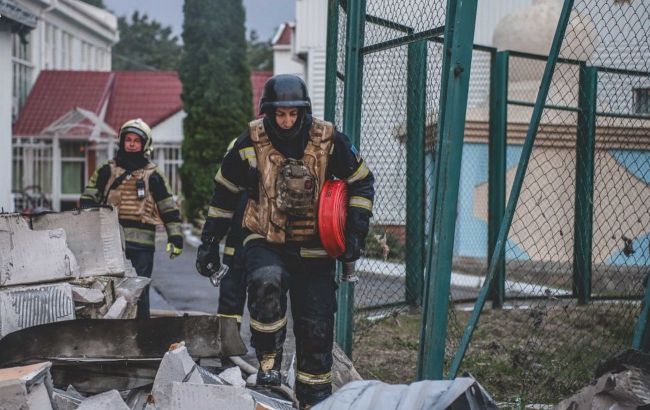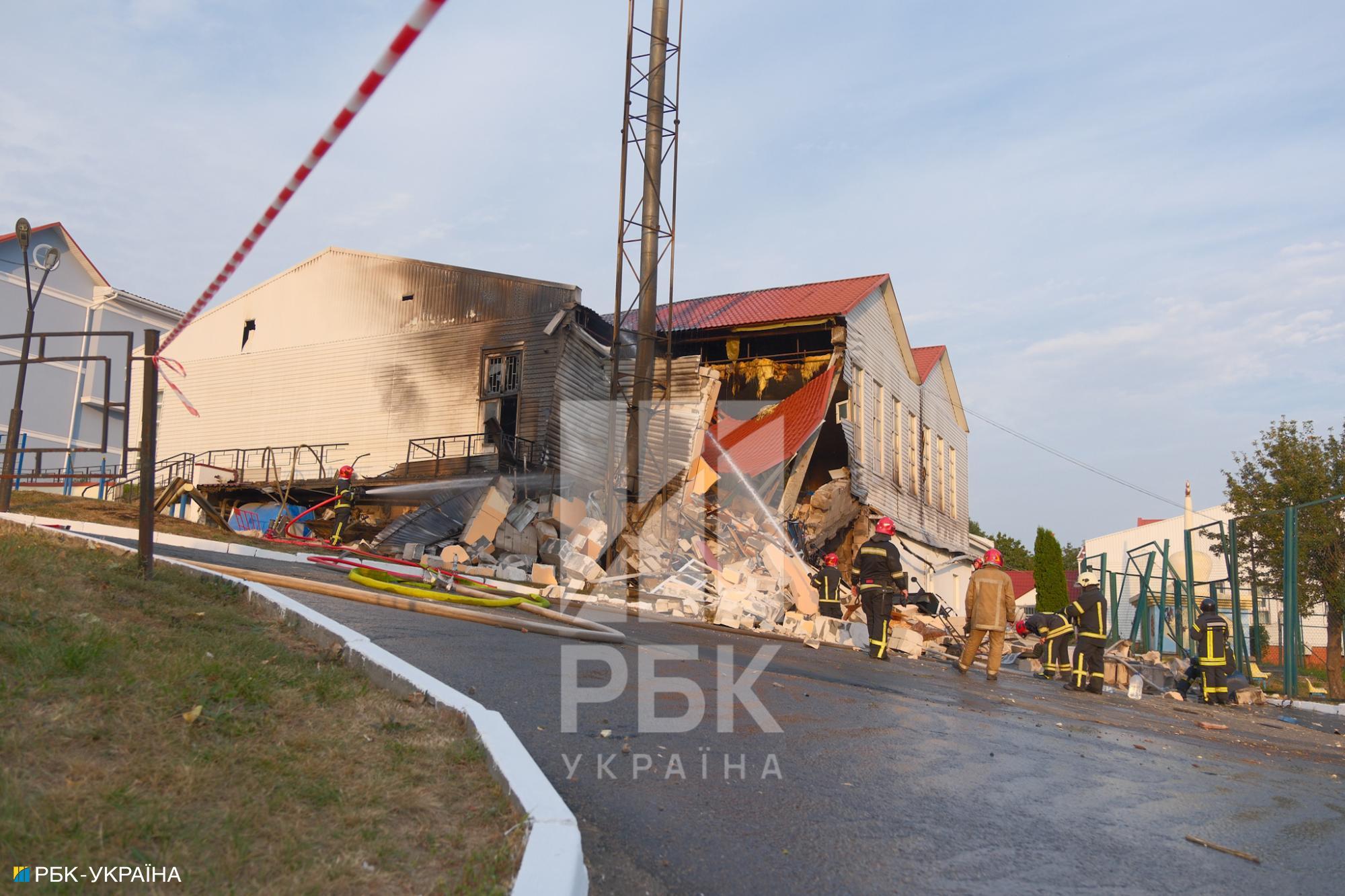Why Russia keeps bombing Kyiv and how long it could last: Experts
 Photo: rescuers eliminate the consequences of the attack on Kyiv on September 2 (Vitalii Nosach/RBC-Ukraine)
Photo: rescuers eliminate the consequences of the attack on Kyiv on September 2 (Vitalii Nosach/RBC-Ukraine)
On the morning of September 2, the Russian Federation launched a massive strike on Kyiv using ballistic and cruise missiles. Debris fell in various districts, with reports of at least three people injured.
RBC-Ukraine investigated why the Russians decided to "shower" Kyiv with missiles and whether more attacks can be expected this fall.
Contents
- What is known about the massive strike on Kyiv
- Why Russia is "showering" Kyiv with missiles
- Will similar attacks continue in the fall
What is known about the massive strike on Kyiv
Today's strike on Kyiv was a combined attack. Initially, at around 03:00, the Russians launched long-range Kh-101 cruise missiles from Tu-95MS strategic bombers. These missiles approached Kyiv from the southern direction after complex maneuvers.
Simultaneously, at around 05:00, ballistic KN-23/Iskander-M missiles were launched at the capital and its suburbs. The combined missile attack was further intensified by the addition of a strike drone.
According to the city military administration, a drone, over a dozen cruise missiles, and around ten ballistic missiles were shot down in Kyiv's airspace.
_1.jpg) Photo: consequences of the rocket attack on Kyiv on September 2 (Vitalii Nosach/RBC-Ukraine)
Photo: consequences of the rocket attack on Kyiv on September 2 (Vitalii Nosach/RBC-Ukraine)
According to the Air Force's report, the enemy launched 35 missiles targeting Kyiv, as well as the Kyiv, Sumy, and Kharkiv regions:
- 16 Iskander-M/KN-23 ballistic missiles from the Bryansk, Voronezh, and Kursk regions
- 14 Kh-101 cruise missiles from the Volgograd region
- 4 S-300/S-400 anti-aircraft guided missiles from the Belgorod region
- One unidentified missile from the Belgorod region
Additionally, the Russians launched 23 Shahed drones from Primorsko-Akhtarsk.
As a result of combat operations, 9 Iskander-M/KN-23 missiles, 13 Kh-101 missiles, and 20 strike drones were shot down. One Kh-101 missile and three drones failed to reach their targets and were lost from radar.
The exact number of missiles directly targeting Kyiv is not specified. According to local authorities, falling debris in the Sviatoshynskyi district caused fires, damaging four vehicles, a non-residential building, and a metro station. One non-residential building was partially destroyed in the Holosiivskyi district, and another was damaged in the Shevchenkivskyi district. Debris was recorded in all districts of the capital.
As of now, three people are reported injured. One received assistance on-site, while the other two were transported to medical facilities.
Updated information indicates that the glass elements of the entrance to the Sviatoshyn metro station were damaged, with nearby kiosks and a two-story building catching fire. The Islamic Cultural Center of the Spiritual Administration of Muslims of the Autonomous Republic of Crimea (near the Nyvky metro station) was also destroyed, and there was a fire at a business in the Shevchenkivskyi district. Additionally, windows were shattered in two schools, but classes proceeded as scheduled. In the Holosiivskyi district, a boiler house was damaged.
Why Russia is "showering" Kyiv with missiles
The likely targets of today's attack may have been the government quarter and so-called "decision-making centers" in Kyiv, including the locations of security agencies, such as intelligence and counterintelligence, according to Oleksandr Musiienko, head of the Center for Military and Legal Studies.
In his view, Russia meticulously prepared for this massive strike to create the appearance that it could penetrate the layered air defense of the Ukrainian capital, especially in light of military advances towards Pokrovsk and the crash of the first F-16.
"This is a psychological tactic of pressure and terror aimed at demoralizing Ukrainians. For their domestic audience, they want to show that, despite drones reaching Moscow and other cities, Russia is still capable of successfully striking Kyiv with missiles," he told RBC-Ukraine.
 Photo: consequences of the rocket attack on Kyiv on September 2 (Vitalii Nosach/RBC-Ukraine)
Photo: consequences of the rocket attack on Kyiv on September 2 (Vitalii Nosach/RBC-Ukraine)
Regarding the preparation, the expert reminds that last week, the Security Service of Ukraine (SSU) detained Russian agents who had installed cameras in an apartment with panoramic windows to monitor targets and assess the impact of the attacks. "This once again indicates that they needed images of massive fires and destructive consequences," Musiienko emphasized.
Thus, the enemy is trying to intimidate Ukrainians and Western audiences by showcasing their capabilities while also bolstering their own propaganda.
"I would even say that all of this is more about diverting attention from the events in the Kursk region. Because they have no success there, they need to distract from what Putin calls a 'provocation' in the Kursk region," the expert added.
Military expert and former spokesperson for the General Staff of the Armed Forces of Ukraine, Vladyslav Seleznov, does not rule out other potential goals. "Summer has passed, the heating season is ahead, and Russia is rushing to do everything possible to plunge Ukraine into a blackout," he said.
According to him, recent missile and drone strikes on Ukraine have increasingly targeted energy infrastructure. However, missiles do not always hit their intended targets, as was the case with the social-psychological support center in Sumy, the sports palace in Kharkiv, or the two schools in Kyiv this morning.
Nevertheless, Seleznov emphasized that the Russians are trying to destroy Ukraine's energy sector. "This is extremely important to them. It's one of the levers they hope to use to pressure the Ukrainian government into accepting Kremlin's capitulation demands," the expert stressed.
Will similar attacks continue in the fall?
Enemy attacks on Kyiv have intensified recently. Musiienko reminds us that in the past two weeks, the Ukrainian capital has been hit by four missile and missile-drone strikes.
"At least once a month, during massive attacks, the enemy directs a significant portion of their missiles at Kyiv. This is likely to continue in the fall. Russia's plans to target the Kyiv Hydroelectric Power Plant, energy facilities, and decision-making centers have not disappeared," he predicts.
In his view, the massive attack on July 8, when missiles reached and struck the Okhmatdyt children's hospital, could have been a turning point. After that, Russia believed that Kyiv's air defenses were vulnerable and that they had a chance to breach them, so they will likely continue trying to do so repeatedly.
According to Seleznov's estimates, the Russians have managed to accumulate a sufficient quantity of ballistic and cruise missiles for terror, particularly against Kyiv.
"We are facing a shortage of air defense systems to guarantee the destruction of enemy ballistic missiles. Currently, we lack the resources to be highly effective in countering Iskanders and North Korean KN-24s. While we managed to destroy all but one cruise missile, dealing with ballistics is more challenging. I believe the enemy has accumulated resources, and there are continuous supplies from Pyongyang, which means the enemy has the capacity to continue striking," the expert stated.
He believes that through combined missile-drone attacks, the Russians will continue attempting to achieve success in destroying Ukraine's energy infrastructure.
Sources: the Air Force of Ukraine, the Kyiv City Military Administration, and Mayor Vitali Klitschko, as well as comments from Oleksandr Musiienko, head of the Center for Military and Legal Studies, and former spokesperson of the General Staff of the Armed Forces of Ukraine, Vladyslav Seleznov.

